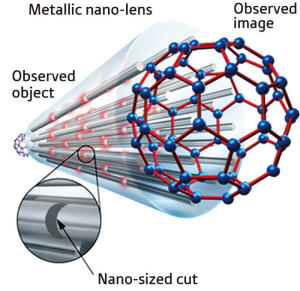New Technique Lights Up the Creation of Holograms
 A red apple with green leaves -- it seems real enough to pick up in one's hand, but there is nothing there to actually touch. This is because the apple is a hologram, a three-dimensional image projected by light. In April 2011, Chief Scientist Satoshi Kawata of RIKEN, the head of the Nanophotonics Laboratory at the Advanced Science Institute in Wako, along with his colleague Miyu Ozaki, a visiting scientist of RIKEN, succeeded in developing a novel holography principle distinct from conventional methods which makes it possible to reconstruct a full-color three-dimensional object. The key to their success resided in superposing a thin silver film on which surface plasmons -- collective oscillations of free electrons within a metal -- were excited. In recent years, research on surface plasmons has rapidly expanded against a background of remarkable advances in nanotechnology, helping establish the subject as a field of engineering. In addition to holograms, Kawata has also undertaken groundbreaking research on surface plasmon applications in metallic nano-lens technology. ...
A red apple with green leaves -- it seems real enough to pick up in one's hand, but there is nothing there to actually touch. This is because the apple is a hologram, a three-dimensional image projected by light. In April 2011, Chief Scientist Satoshi Kawata of RIKEN, the head of the Nanophotonics Laboratory at the Advanced Science Institute in Wako, along with his colleague Miyu Ozaki, a visiting scientist of RIKEN, succeeded in developing a novel holography principle distinct from conventional methods which makes it possible to reconstruct a full-color three-dimensional object. The key to their success resided in superposing a thin silver film on which surface plasmons -- collective oscillations of free electrons within a metal -- were excited. In recent years, research on surface plasmons has rapidly expanded against a background of remarkable advances in nanotechnology, helping establish the subject as a field of engineering. In addition to holograms, Kawata has also undertaken groundbreaking research on surface plasmon applications in metallic nano-lens technology. ...
"The key to successfully extracting RGB separately from white light resides in superposing a thin silver film onto light-sensitive material. In doing so, surface plasmon polaritons (SPPs) are excited on the thin film," says Ozaki. ...
Read the full story here;